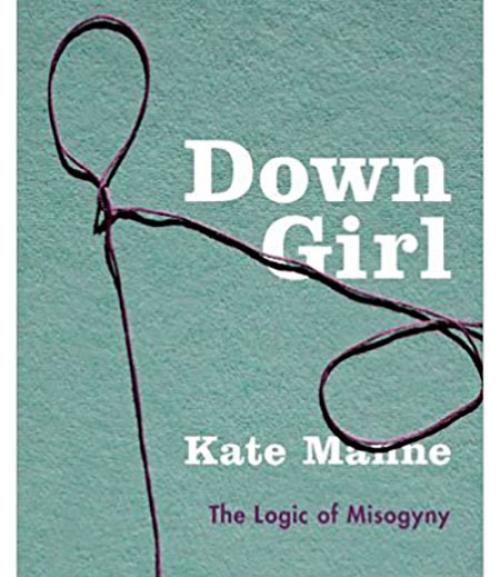Why does misogyny persist, even in supposedly post-patriarchal parts of the world, like the U.S.? asks Kate Manne in her timely book, “Down Girl: The Logic of Misogyny” (Oxford University Press, 2018). Despite social progress toward equality, says Manne, the stories exposed during the #MeToo movement demonstrate that misogyny and wrongful, entitled male behavior is an enduring problem in our society.
Manne draws an important distinction between misogyny and sexism. Sexism is the belief system that justifies and rationalizes treating women as inferior to men in masculine-coded domains—such as business, STEM fields, and political leadership—or treating women as particularly well-suited to playing feminine-coded social roles—involving giving sympathy, care, nurture, as well as emotional and reproductive labor. In contrast to sexism, misogyny is the “law enforcement” branch of patriarchy, which serves to police and enforce a patriarchal social order. According to Manne, it is the system that upholds patriarchal norms and expectations by threatening and punishing women who try to enter male-dominated spaces, take masculine-coded powers or privileges away from men, or are perceived as withholding feminine-coded goods and services from their socially sanctioned beneficiaries.
Women who violate patriarchal social norms are often met with misogynistic hostility and may be characterized as pushy, shrill, nasty, or abrasive, among other possibilities. “Women who do not violate patriarchal social norms are still vulnerable to misogyny, however; they may be treated as an outlet for aggression as a representative of a certain ‘type’ of woman, or bear the brunt of misogynistic ‘punching down’ behavior,” says Manne. “And non-binary people may be still more vulnerable to similar forms of mistreatment, as well as distinctive forms of gendered policing.”
Hillary Clinton’s treatment during the presidential campaign was unsurprising to Manne, and she had predicted that Clinton would lose the election to Trump due to an enthusiasm gap. Manne believes that women are understood to be fully human—all too human—at this point in human history. But she argues women are often positioned as human givers of feminine-coded goods they are held to owe to others, rather than treated as human beings in their own right, free to pursue a wider range of social possibilities. “She is not allowed to be—or aspire to be—in the same ways as he is,” Manne says. Women who compete for powerful roles with men will hence tend to be seen as morally suspect, she writes, “insufficiently caring and attentive with respect to those in her orbit deemed vulnerable; illicitly trying to gain power to which she is not entitled; and morally untrustworthy, given the other two kinds of role violations.” Such moral suspicions may be harbored and subject to post hoc rationalizations by women as well as men, who misogyny gives powerful incentives to be “good” by adhering to patriarchal norms and expectations.
Pointing out misogyny is necessary to solve it, but often makes for a Catch-22 situation, according to Manne. When women do so, they are withholding the approval, admiration, deference, and good will to which men may be deemed entitled. Moreover, her identifying as the victim of men’s misogynistic behavior can seem like her wronging a male perpetrator by causing him the pain of guilt, shame, embarrassment, or being held accountable for his actions. She may also be dismissed as a liar or as self-pityingly “playing the victim.” “It follows that misogyny is a self-masking phenomenon: trying to draw attention to the phenomenon is liable to give rise to more of it,” writes Manne.
A related form of unwitting gendered moral bias is what Manne calls “himpathy,” when people make excuses for a male perpetrator and sympathize with him rather than his female victim. Manne also notes that people have been prepared to condemn older men like Harvey Weinstein as creepy, predatory “monsters,” but more inclined to find excuses for privileged, younger “golden boys” accused of sexual assault and harassment, like Ed Westwick and James Franco. Himpathy is closely related to “mansplaining,” says Manne, in which women are expected to provide a passive, appreciative audience to a man holding forth on topics the woman may already know all about.
Manne first became interested in misogyny after the Isla Vista shootings, in which the killer, Elliot Rodger, wanted to punish women of the Alpha Phi sorority house at the University of California, Santa Barbara, for failing to give him the “love, sex, attention, and admiration” he craved so sorely. Many commentators denied and downplayed the importance of misogyny in explaining Rodger’s actions. Her research found little in analytic feminist philosophy explicitly defining the term “misogyny” and thus inspired her to write the paper that grew into this book. Her own experience, as one of only three girls in an all-male high school, helped inform her interest in the topic, though she notes that there is no universal experience of misogyny; it is dependent on intersecting social factors, such as race, class, disability, age, sexuality, being cis/trans, and so on.
“Down Girl” is intended as a “crossover” book, she says, for a general audience as well as for other academic philosophers to read and teach from. Each chapter is designed to be self-contained enough to be read on its own, though the chapters are also interconnected and the themes build upon each other. Manne examines recent events, including the case of the convicted serial rapist Daniel Holtzclaw, who preyed on African-American women as a police officer in Oklahoma City, Rush Limbaugh's diatribe against Sandra Fluke, and the "misogyny speech" of Julia Gillard, then Prime Minister of Australia, which went viral on YouTube, and shows how these events, among others, set the stage for the 2016 US presidential election.




